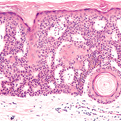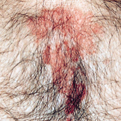Seborrheic Keratosis
General Information
Seborrheic Keratosis is one of the most common types of benign tumors in older adults. Usually appearing as a brown, black or pale lesions located on the face, chest, shoulders or back. They have an appearance of a greasy scale or wart-like growth. Seborrheic keratosis may appear as a single growth but multiple growths on individuals are more common. Some research suggests that seborrheic keratosis are genetically inherited, others report sunlight playing a role in the development. Treatment of seborrheic keratosis is not necessary, although some individuals may want them removed due to cosmetic appearance or medical reasons including intense pruritus, pain, inflammation, bleeding or infection. Removal of seborrheic keratosis may be performed using several methods including cryosurgery, curettage or electrocautery.
Epidemiology
Most common benign tumor in older individuals
Etiology
Unknown; Genetics may play a role
Pathogenesis
Epidermal growth factors or their receptors have been implicated in the development
Clinical
Initially one or more sharply defined light brown flat lesion usually less than 1 cm in diameter.
Histology
Melanocytes may be increased slightly in number, but they are small and monomorphous, equidistant from one another, and positioned entirely at the dermoepidermal junction.
Bibliography
1. “Seborrheic Keratosis” (Online). July 2006. http://www.emedicine.com/DERM/topic397.htm (visited: March 20, 2008) 2. “Seborrheic keratosis” (Online). November 2006. http://www.mayoclinic.com/health/seborrheic-keratosis/DS00846 (visited: March 20, 2008)
Download PDF
![]() Seborrheic Keratosis
Seborrheic Keratosis


